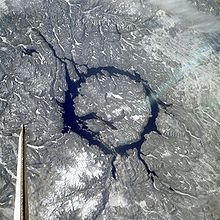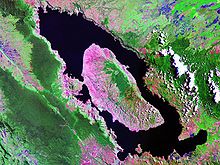- Crater lake
-
This article is about the geological feature. For the lake of the same name in Oregon, see Crater Lake. For other uses, see Crater Lake (disambiguation).
 Satellite imagery of Manicouagan Reservoir / Manicouagan impact crater, the largest impact crater lake in the world.
Satellite imagery of Manicouagan Reservoir / Manicouagan impact crater, the largest impact crater lake in the world.
A crater lake is a lake that forms in a volcanic crater or caldera, such as a maar; less commonly and with lower association to the term a lake may form in an impact crater caused by a meteorite. Sometimes lakes which form inside calderas are called caldera lakes, but often this distinction is not made. Crater lakes covering active (fumarolic) volcanic vents are sometimes known as volcanic lakes, and the water within them is often acidic, saturated with volcanic gases, and cloudy with a strong greenish color. Lakes located in dormant or extinct volcanoes tend to have fresh water, and the water clarity in such lakes can be exceptional due to the lack of inflowing streams and sediment.
Contents
Formation
Crater lakes form as precipitation within the rim fills the created depression. The water level rises until an equilibrium is reached between the rate of incoming and outgoing water. Sources of water loss singly or together, may include evaporation, subsurface seepage, and in places, surface leakage or overflow when the lake level reaches the lowest point on its rim. At such a saddle location, the upper portion of the lake is contained only by its adjacent natural volcanic dam; continued leakage through or surface outflow across the dam can erode its included material, thus lowering lake level until a new equilibrium of water flow, erosion and rock resistance is established. If the volcanic dam portion erodes rapidly or fails catastrophically, the occurrence produces a breakout or outburst flood. With changes in environmental conditions over time, the occurrence of such floods is common to all natural dam types.
A well-known crater lake, which bears the same name as the geological feature, is Crater Lake in Oregon, USA. It is located in the caldera of Mount Mazama, hence the name "Crater Lake" is something of a misnomer. It is the deepest lake in the United States with a depth of 594 m (1,949 ft). Crater Lake is fed solely by falling rain and snow, with no inflow or outflow at the surface, and hence is one of the clearest lakes in the world.[1]
The highest volcano in the world, 6,893 metres (22,615 ft) Ojos del Salado, has a permanent crater lake about 100 metres (300 ft) in diameter at an elevation of 6,390 m (20,960 ft) on its eastern side.[2] This is most likely the highest lake of any kind in the world.
Due to their unstable environment, some crater lakes exist only intermittently. Caldera lakes in contrast can be quite large and long-lasting; for instance, Lake Toba formed after its eruption around 70,000 years ago and has an area of over 1,000 square kilometres.
While many crater lakes are picturesque, they can also be deadly. Gas discharges from Lake Nyos suffocated 1,800 people in 1986, and crater lakes such as Mount Ruapehu's often contribute to destructive lahars.
Lakes can also fill impact craters, but these are not usually referred to as crater lakes except in a few isolated cases. Example of such impact crater lakes include Manicouagan in Canada, Lake Bosumtwi in Ghana and Siljan in Sweden.
List of volcanic crater lakes
List of meteor crater lakes
Lake Location Africa Lake Bosumtwi Ghana Asia Lonar crater lake India Europe Lake Kaali Estonia Lake Siljan Sweden Dellen Sweden North America Lake Manicouagan Canada West Hawk Lake Canada References
- ^ "Facts and Figures about Crater Lake". U.S. National Park Service. http://www.nps.gov/archive/crla/brochures/facts.htm. Retrieved 2009-03-17.
- ^ Andes Website - Information about Ojos del Salado volcano, a high mountain in South America and the World's highest volcano
- ^ http://www.gtz.de/de/praxis/11695.htm Description of Mount Wenchi crater lake on the website of GTZ
- ^ Kahumana Sanctuary - Geology
Further reading
- Delmelle, Pierre; Bernard, Alain (2000). "Volcanic Lakes". In Sigurdsson, Haraldur. Encyclopedia of Volcanoes. San Diego: Academic Press. 1999. pp. 877–895. ISBN 012643140X
- Varekamp, Johan C.; Rowe, Gary L. , Jr. (eds.) (2000). "Crater Lakes". Journal of Volcanology and Geothermal Research 97 (1–4): pp. 1–508. http://www.sciencedirect.com/science?_ob=PublicationURL&_tockey=%23TOC%235962%232000%23999029998%23197405%23FLA%23&_cdi=5962&_pubType=J&view=c&_auth=y&_acct=C000029718&_version=1&_urlVersion=0&_userid=582538&md5=1911beba4cc7a30b37f932dac1925ca9. (entire volume about crater lakes)
- Pasternack, G. B.; Varekamp, J. C. (1997). "Volcanic lake systematics I. Physical constraints". Bulletin of Volcanology 58 (7): pp. 526–538. http://www.springerlink.com/content/fe99wvduu106pwpu/?p=bd7fb6cabac34210ace7b7edcfd9f13a&pi=2.
- Kusakabe, Minoru (ed.) (1994). "Geochemistry of Crater Lakes". Geochemical Journal 28 (3): pp. 137–306. http://www.terrapub.co.jp/journals/GJ/frame/28.html. (entire issue about chemistry of crater lakes)
External links
- IAVCEI Commission of Volcanic Lakes
- IAVCEI Commission of Volcanic Lakes: Some fundamentals about Crater Lakes
- The Science of Volcanic Lakes
- Volcanic Lakes of the World
- USGS Hawaiian Volcano Observatory: Water on volcanoes: heavy rain and crater lakes
- USGS Cascades Volcano Observatory: Volcanic Lakes
- The Science of Volcanic Lakes, Greg Pasternack, U. California Davis
- Crater Lake National Park documentation in Building Oregon: Architecture of Oregon & the Pacific Northwest archive
Categories:- Crater lakes
Wikimedia Foundation. 2010.





